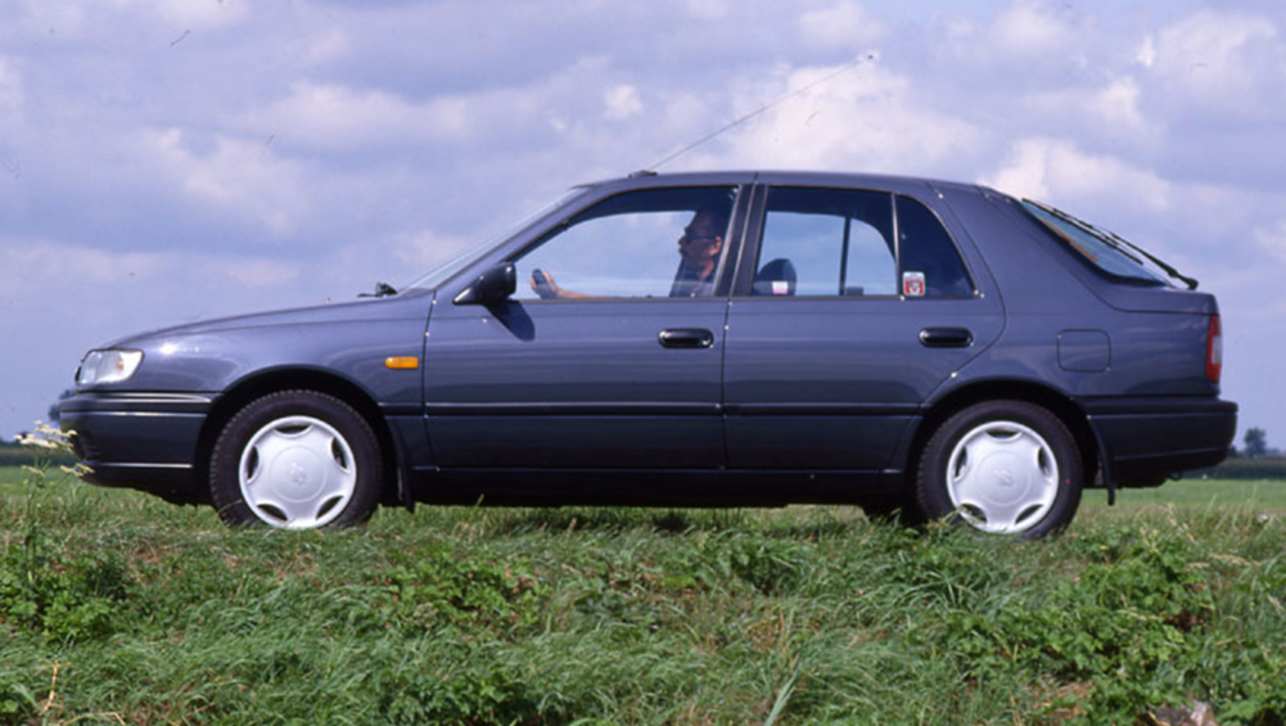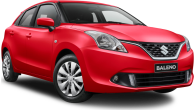So highly rated was the N14 Nissan Pulsar that one leading Australian motoring magazine gave it equal car-of-the-year status with the high performance Honda NSX sports car.
When the popular front-wheel drive N14 Pulsar was launched in 1991 it came out of Nissan’s Clayton factory in Melbourne, but in 1993 Nissan ceased local production and from then on it was fully imported from Japan.
Models
The N14 Pulsar was typical of the era with a soft, rounded shape. The result was a pleasing little car that was quite attractive for the time.
Nissan offered two body styles, a conservative four-door sedan and a more practical five-door hatch.
At the beginning, the range consisted of the entry level GLi, the value-packed and popular Q, luxury Ti, and acclaimed SSS sports hatch.
The GLi came in sedan and hatch forms, with a 1.6-litre engine and a choice of manual gearbox or automatic transmission.
Like all small cars of that time it was fairly basically equipped. Standard features listed were cloth trim, the steering column could be adjusted for tilt, and there was a radio/cassette player with the sound coming from two speakers.
The Q was the most popular model in the range, it was only available as a hatch, but with a choice of 1.6-litre or 2.0-litre engines, and manual gearbox or automatic transmission.
Q buyers enjoyed cloth trim, tilt adjustment for the steering column, power steering, power rear view mirrors, and a radio/cassette player boasting four speakers. In addition, if they opted for the larger engine they also got remote central locking.
The sporty SSS was the hero of the N14 range. It was only available as a hatch, and only came with the 2.0-litre engine, but there was the choice of manual gearbox or automatic transmission.
Standard features consisted of 14-inch alloy wheels, a rear spoiler, sports-tuned suspension, sports steering wheel, front fog lamps, cloth trim, air conditioning, central locking, power windows and mirrors, power steering, and radio/cassette player with four speakers. ABS brakes were an option.
If the SSS was the sporty hero of the Pulsar range, the Ti appealed to those looking for a more prestige ride.
It was available as a sedan and hatch, and came standard with the 2.0-litre engine, and the choice of manual gearbox or automatic transmission.
Befitting its prestige image it had air conditioning, central locking, velour trim, premium sound, power windows, power steering, and a sports steering wheel. Cruise control was an option.
When Nissan ceased local production in 1993 the Pulsar became a fully imported model from Japan.
There were some minor cosmetic changes, including grilles, and the GLi was replaced as the entry model by the LX.
The LX was available as a sedan or hatch; it had a 1.6-litre engine as standard, and the choice of manual gearbox or automatic transmission.
Standard features were central locking, cloth trim, and a radio/cassette player with two speakers. Power steering was optional.
The Q, Ti and SSS carried on in imported form, but the Q and Ti then had the 1.6-litre engine, and SSS was only available with a manual gearbox.
There was a notable absence of passive safety features, like airbags, but ABS anti-lock braking was available as an option on the SSS. A sunroof was another option on the SSS.
There was also a notable absence of modern day features, there was no climate control for the air conditioning, no sat nav, touch screen, rear parking parking sensors, reversing camera, or park assist.
Bluetooth was unheard of then, so there was no possibility of syncing an iPhone or Android device.
The spare tyre was a full-sized one.
Cabin
Inside, the Pulsar won many fans with the quality of its trim and plastic bits and pieces.
Road noise was relatively high, and there was some criticism of the rear seat room, which was compromised by Nissan’s use of vertical strut rear suspension that cut into the rear accommodation room.

But if you only needed to carry two adults and a couple of kids there was more than enough space, and the impressive load space behind the rear seats more than made up for any perceived lack of rear passenger space.
Storage wasn’t considered a high priority in 1991, so there are few nooks to stow the things you want to take with you. Cupholders weren’t a high priority, either.
Engine
Two twin-cam fuel-injected four-cylinder petrol engines provided the power for the N14 Pulsar.
One was a 1.6-litre unit, which was standard on the GLi and Q.
It was locally assembled and had a simple form of variable cam timing on the inlet camshaft. While not as complex as others it nevertheless gave the Pulsar plenty of bottom end flexibility for easy drivability and miserly fuel consumption, at the same time delivering impressive performance.
Peak power was 81kW (108 horsepower) at 6000rpm, the maximum torque 147Nm at 4000rpm.

The other was a zesty imported 2.0-litre engine, which was an option in the Q and standard in the SSS, and also the Ti until 1993.
It boasted peak power of 105kW (140 horsepower) at 6400rpm and top torque of 179Nm at 4800rpm.
Both engines used 91-octane regular unleaded petrol.
There was a choice of an excellent five-speed manual gearbox and a four-speed electronic automatic transmission, which were both well matched to the engines and user-friendly.
Driving
Driving the N14 Pulsar was fun; particularly the SSS with its sports-tuned independent front suspension, and strut rear suspension.
The handling was widely praised with a nice balance and reassuring stability, while the ride was rated well controlled if a little firm.
Safety
Safety wasn’t at the forefront of carmakers thinking when the N14 came out, and as such the small Nissan had few safety features.
There were no airbags at all, lap/sash front seat belts were about as good as it got.
It was the same with active safety features, ABS braking was limited to the SSS, and then it was an option. There was no traction control, no stability control, or any of the other safety systems that went along with ABS.
Fitting a baby car seat wasn’t easy, which really makes the car unsuitable for a family today.
It was also before the advent of ISOFIX child seat mounting points.
Any common issues?
The most important thing to understand about the N14 Pulsar is that it is now an old car, a very old one.
Buy one in good condition that has been well cared for and you could be on a winner, but buy one that has been neglected over the years and you’ve more than likely got a nightmare on your hands.
When new the N14 Pulsar was rated highly for its build quality and solid feel. The quality of its production was regarded as among the best in its class and better than many higher priced cars of the same era. That generally translated into reliability in service.
While that was certainly true in the years following its launch in 1991, it’s not necessarily the case now. Buying a car that’s as much as 25 or more years old, as the N14 now is, requires careful consideration.
Any car that old is likely to have problems, purely and simply through wear and tear from normal use.
On average a 25-year-old car could be expected to have done half a million kilometres, that’s a lot in anyone’s language.
The 1.6-litre engine is durable and trouble free, and economical to run, while the 2.0-litre has good performance. It too is durable and gives little trouble.
Both engines have a cam timing chain which means apart from regular retensioning there’s no servicing requirement.
Expect to find wear in the engine, even if it has been regularly serviced, so look for smoke from the tailpipe.
Check the operation of the automatic transmission, particularly the way it engages gears, and any flaring or surging while driving.
You could also expect wear in suspension components, such as shock absorbers, bushes, and joints.
The Pulsar’s body is tough and generally robust, but closely inspect it for signs of previous crash repairs, fading paint, and rust.
While it’s always important to check for a service record, a car as old as the N14 is more than likely to not have one. In the absence of a record of regular maintenance quiz the owner to get a feeling for how diligent they have been in looking after their car.
The N14 came in before the idea of capped price servicing, but there’s nothing that should make the service costs excessive.
When new the N14 Pulsar came with warranty for three years/100,000km.
MORE: If anything crops up, you’ll probably find it on our Nissan Pulsar problems
Rivals
Toyota Corolla
Well built, generally sound, and reliable.
2 stars.
Ford Laser
Mazda-built small Ford is a worthy alternative if in good condition.
2 stars.
Mitsubishi Lancer
Basic but solid and reliable, a good alternative.
2 stars.
Verdict
Great little car when new, but age is now a worry.
Nissan Pulsar 1991: GL
| Engine Type | Inline 4, 1.6L |
|---|---|
| Fuel Type | Unleaded Petrol |
| Fuel Efficiency | 9.0L/100km (combined) |
| Seating | 5 |
| Price From | $1,380 - $2,200 |








.jpg)

.jpg)












































.jpg)
Comments